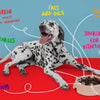What, When and How?
- by Robert Wolff
Puppies
-
What: Puppy-specific formulas rich in protein and essential nutrients.
-
When: 3-4 meals per day until they are about six months old, then transition to two meals.
-
How: Measure portions carefully and introduce new foods gradually to avoid upsetting their sensitive stomachs.
Adult Dogs
-
What: High-quality adult dog food tailored to their breed, size, and activity level.
-
When: Two meals per day—morning and evening.
-
How: Use a standard measuring cup and avoid free-feeding to maintain a healthy weight.
Senior Dogs
-
What: Senior formulas with joint-supporting nutrients like glucosamine and reduced calories for less active dogs.
-
When: Two meals per day, adjusted based on their activity level and health.
-
How: Monitor their appetite and consult your vet for dietary adjustments as needed.
Small Breeds
-
What: Calorie-dense food with smaller kibble sizes.
-
When: 2-3 meals per day to maintain energy levels.
-
How: Offer measured portions and avoid overfeeding.
Large Breeds
-
What: Food with balanced protein and fat, and nutrients to support joints and muscles.
-
When: Two meals per day, avoiding large meals to prevent bloat.
-
How: Feed at regular times and ensure they rest after eating.
Active and Working Dogs
-
What: High-calorie diets with increased protein and fat content.
-
When: Two or more meals per day depending on activity level.
-
How: Provide meals before and after exercise to sustain energy levels.
7. Monitor Your Dog’s Health
Feeding your dog properly also involves paying attention to how their diet affects their health. Look out for signs of digestive issues, skin problems, or changes in energy levels. If you notice anything unusual, consult your veterinarian.
Conclusion
Feeding your dog properly is a cornerstone of responsible pet ownership. By choosing high-quality food, managing portion sizes, incorporating healthy treats, and maintaining a consistent routine, you can ensure your dog stays happy and healthy for years to come. Remember, every dog is unique, so consult your veterinarian to tailor your approach to your pet’s specific needs.



